The Top 12 Ecommerce Marketing Trends for 2025 (and Beyond)
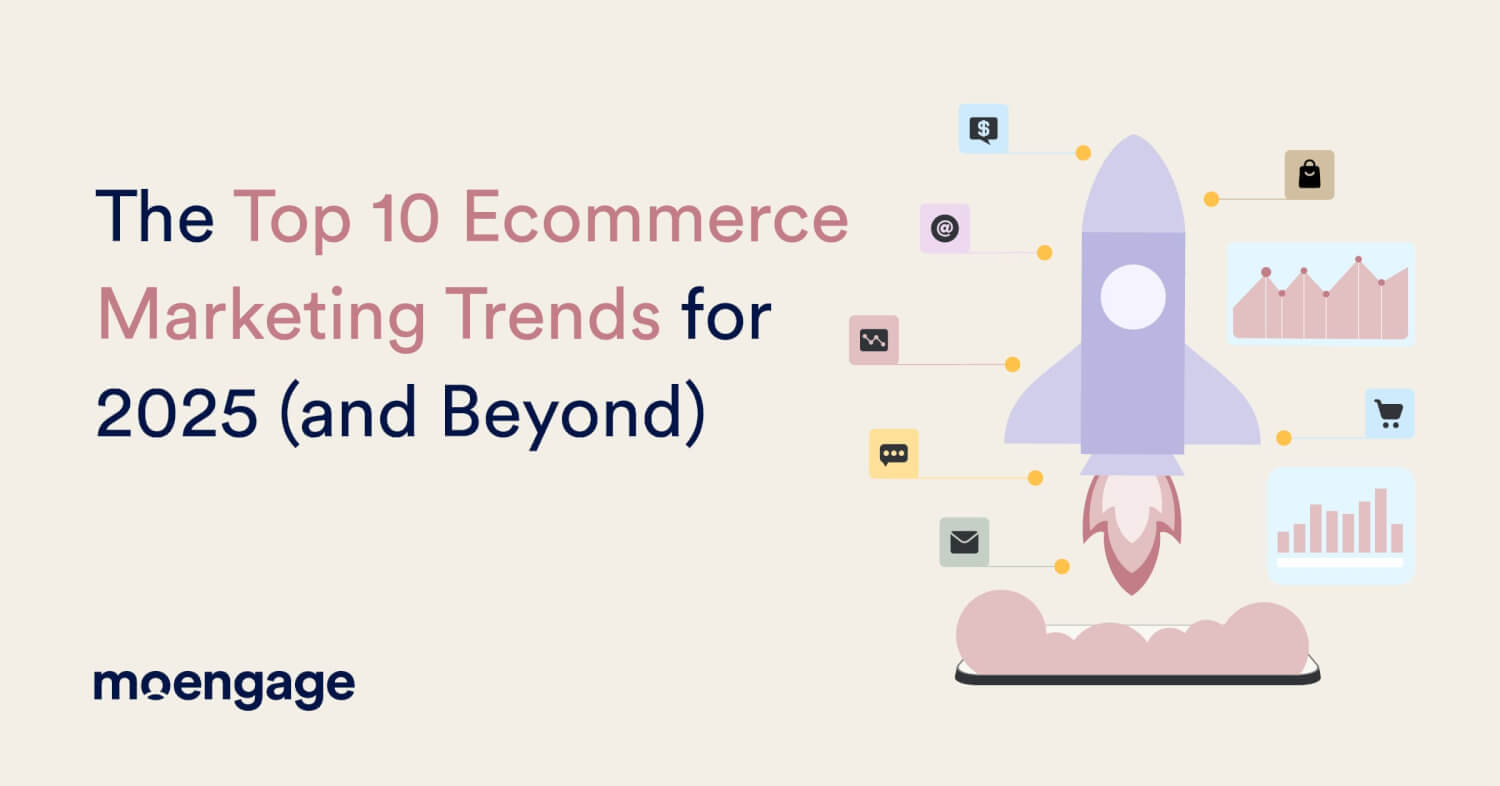
Reading Time: 12 minutes
Ecommerce epitomizes the modern consumer economy. It prioritizes speed, convenience, and efficiency over an in-store experience with a personal touch, making it the preferred choice for many shoppers.
In fact, ecommerce is taking a huge share of the entire sales market. In 2023, ecommerce sales accounted for 19.5% of worldwide retail sales at a total value of $5.78 trillion. This is expected to grow to a total of $6.88 trillion and 21.2% in 2025 and $7.47 trillion and 22.2% in 2026; and brands are investing in ecommerce just as heavily.
The ecommerce marketing landscape is always changing to meet the demands of consumers and leverage advancements in technology. For ecommerce marketers to achieve success and consistently engage their customers, they need to be aware of the most current ecommerce trends so they can provide best-in-class experiences for their customers.
Below, we look at ecommerce trends that are going to be the most popular — and have the greatest impact — in the near future.
12 Ecommerce Marketing Trends to Consider For Your Upcoming Campaigns
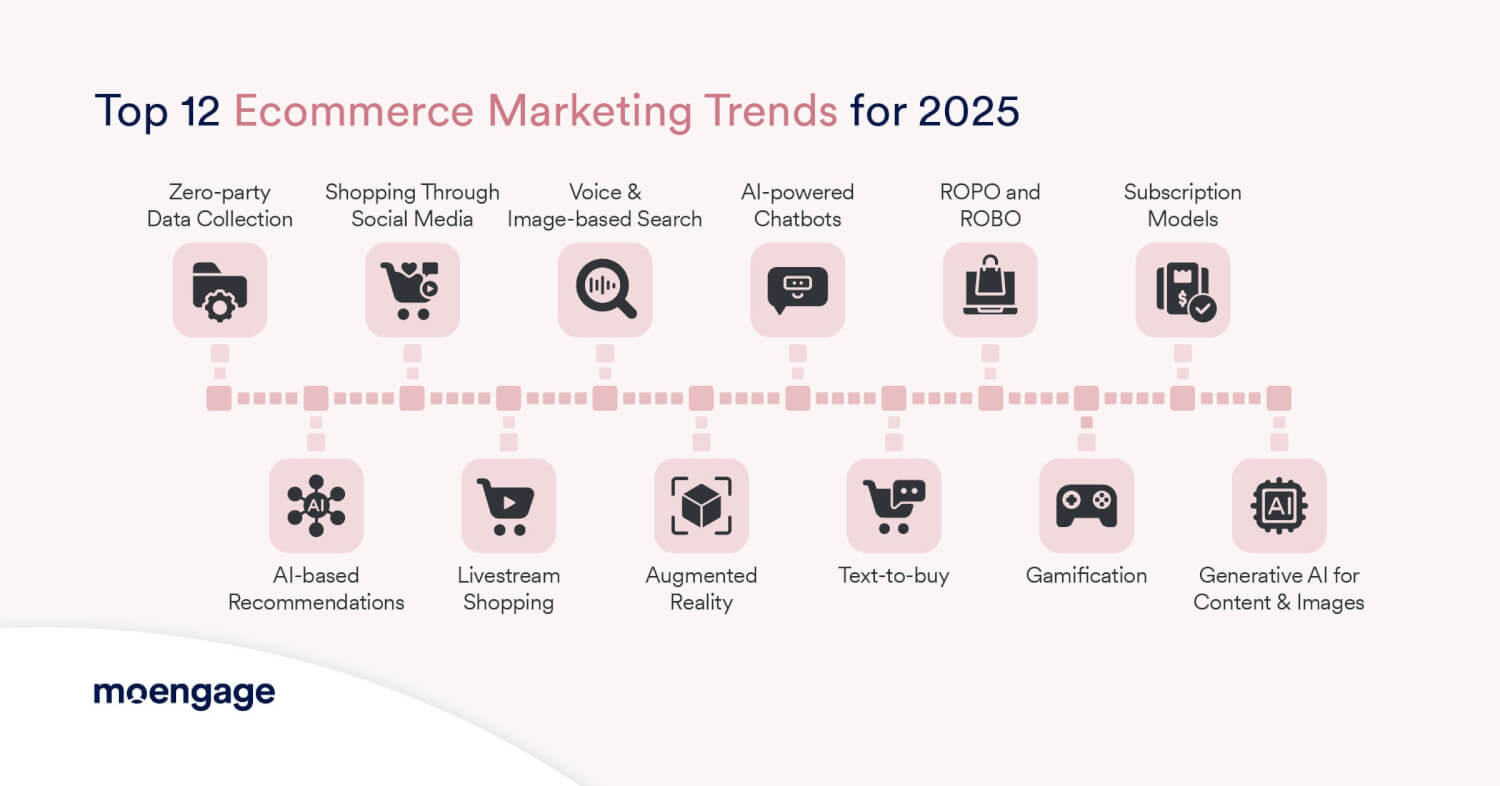
Here, we cover the top twelve ecommerce marketing trends to watch in the near future.
1. Collecting zero-party data from customers
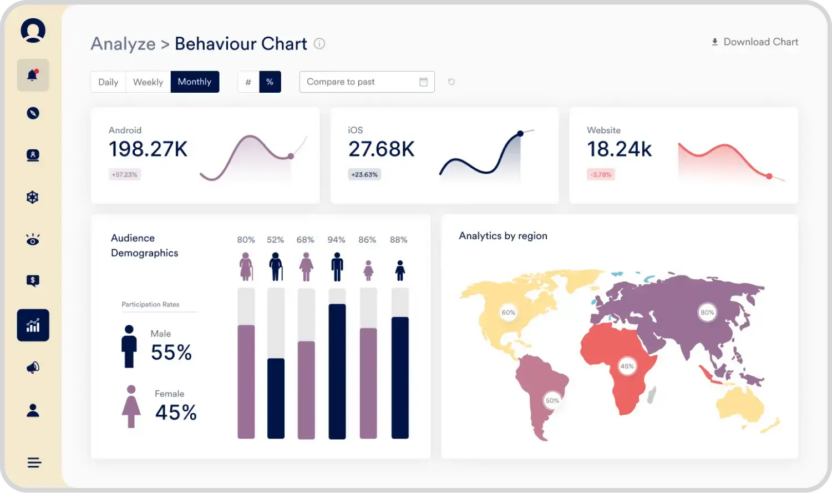
Perfecting customer experiences so they stick around is all about understanding what they are interested in and care about most in the shopping experience. But to deliver these hyper-personalized journeys, you need to have reliable, actionable insights about your customers.
Zero-party data refers to data that customers have voluntarily shared with your brand through surveys, questionnaires, pop-ups, and more. Since it’s direct from the source, you can trust its accuracy and reliability.
Modern, digital-first customer engagement makes this easier than ever for your businesses to collect zero-party data from your customers. Hence you should develop omnichannel customer journeys that incorporate feedback loops and entice customers to submit reviews of your products and services, as well as their overall experience with your brand.
These insights can be used to inform product recommendations and develop customer purchase journeys that maximize engagement.
2. Delivering hyper-personalized recommendations and offers with AI

Modern customers expect their brand experiences to speak uniquely to them. Successful ecommerce marketers deliver personalized experiences for their customers from their first interaction through to their last.
Leading brands offer personalized website experiences that dynamically display content for customers based on their past activity and personal preferences. This ensures product recommendations, offers, and other marketing communications resonate with customers, leading to greater traction and higher conversion rates.
But this is extremely difficult to do at scale when serving thousands, if not millions, of customers. To solve this problem, brands can now use AI to analyze customer data, purchase patterns, and individual preferences and then suggest relevant products. By ensuring your website, mobile app, and digital advertisements are dynamically personalized based on your customers’ interests, you drastically increase both engagement and conversions.
3. Directing shopping through social media posts and stories
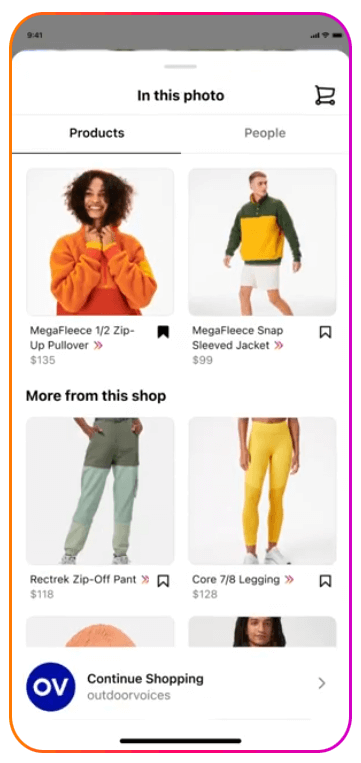
Since its inception, social media has been used by ecommerce sites as a marketing tool to generate interest, leads, and engagement with their brand. It’s used to increase brand awareness, advertise products and services, and develop long-term relationships with customers. However, it often had limitations in terms of facilitating direct sales.
But many popular social media platforms — like Instagram, TikTok, and Facebook — have enabled direct sales via social media posts and stories. This gives customers access to one-click checkouts that let them go directly from browsing an item on social media to making an immediate purchase, without ever leaving the social media platform.
In the coming years, ecommerce marketers will see a greater shift where social media platforms move from being primarily a marketing tool used for promotion, lead generation, and relationship building, to a marketplace for direct sales.
Social media platforms will certainly retain their promotional nature and value, and will therefore still serve as an incredible marketing and lead-generation vessel. At the same time though, they will become a sales vessel that makes it easier, faster, and more convenient for social media users to buy from brands.
4. Conducting livestream shopping via social media
The new generation of shoppers is bringing back the classic ‘As seen on TV’ shopping experience, replacing the outdated, televised version with a more modern take — livestream shopping.
Also known as live commerce, livestream shopping involves real-time online shopping events that are live-streamed by a host. Participants can watch live product demos, ask questions via chat, react via emojis, and place online orders for the products being showcased. Essentially, it’s a modern version of teleshopping where brands promote their products via live social media events.
With a growing, mature market in China, North American brands are taking note of this new ecommerce trend, marked by the introduction of Amazon Live, TikTok Live, and other alternatives. These investments point to a growing livestream shopping economy that provides customers with a more immersive, engaging shopping experience; one that gives them the ability to deal with a real brand representative and ask questions in real time.
Poshmark, an ecommerce marketplace for buyers and sellers, is investing heavily in the livestream shopping trend with their newest offering — Posh Party Live. This enables real-time shopping events where users can host live auctions and foster active engagement.
Brands looking to excel in this space will need to focus on providing customers the convenience of online shopping with the personal touch of in-store shopping, as well as leveraging limited-time deals that incentivize real-time purchases during these live events.
5. Optimizing for voice & image-based searches

Voice assistants like Amazon Alexa, Google Assistant, and Apple’s Siri have fundamentally changed how people find information on the weather, consume the news, and manage their lives. According to Statista, worldwide ecommerce transaction values via voice assistants totaled $19.4 billion in 2023, up from just $4.6 billion in 2021. As the technology changes and more customers adopt voice assistants, voice search will continue to grow in popularity (and quality).
Alongside this, image search technology has taken huge strides in the last few years, spurred on by the increase in AI capabilities. Brands are now finding innovative ways of integrating image search functionality to deliver more streamlined, convenient shopping experiences to customers.
Amazon Lens lets customers search for products using an image; simply snap a photo of something, and Amazon will search for similar products. Similarly, customers can use augmented reality to view items in their room, allowing them to visualize how furniture would fit and look in their home. ASOS has also implemented a visual search tool that helps customers recreate styles they see in other stores, in films, or on their friends.
As this trend continues to grow, ecommerce marketers will need to understand how their customers use voice and image search and devise intuitive ways to leverage these features for increased engagement and conversions. They will need to optimize their website, mobile app, and other channels for voice and image search accessibility for customers who prefer using these tools for their shopping needs.
They will need to go beyond building simple search queries, and instead allow customers to ask questions that help them make product comparisons and find the products they want most. This will help to funnel customers further down the purchase journey, potentially even enabling them to make purchases using this technology as well.
6. Using augmented reality (AR) for product visualization

One of the biggest shortcomings of online marketing is that customers can’t physically see, touch, or smell the products they’re shopping for. As you can imagine, it’s awfully challenging to choose candles when you can’t actually smell the different scents, and are instead relying only on descriptions.
But even in-store shopping has its limitations. Whether customers are shopping online or in-store, they aren’t able to visualize what furniture actually looks like inside their home. Similarly, customers shopping for makeup products aren’t able to try on products that they see online or in-store, and instead have to take their best guess at which tone matches their skin.
Using Augmented Reality (AR) technology, brands are enabling customers to visualize products in new and innovative ways. Brands like IKEA use AR to enable customers to visualize furniture inside their homes, helping them find the perfect fit. Being able to actually visualize products in their home makes it much easier to match fabrics, textures, and tones. It also allows customers to fully and accurately map out their floorplan or renovation. Sephora uses AR to allow customers to virtually try on products, so they can see what they’d look like wearing whichever makeup product they are shopping for.
According to eMarketer, there will be more than 110 million AR users in the US by the end of 2025. With nearly a third of the population using Augmented Reality (AR) tech, there is no doubt that leading ecommerce retailers will use this technology to set themselves apart from their competitors in innovative ways.
Leading brands are using AR to showcase their products in interesting and existing ways, helping them convert more effectively. Whether that’s by streamlining the process or providing the customer with a more valuable, insightful shopping experience, these experiences are changing the way customers shop both online and in-store.
7. Leveraging AI-powered chatbots to retain customers
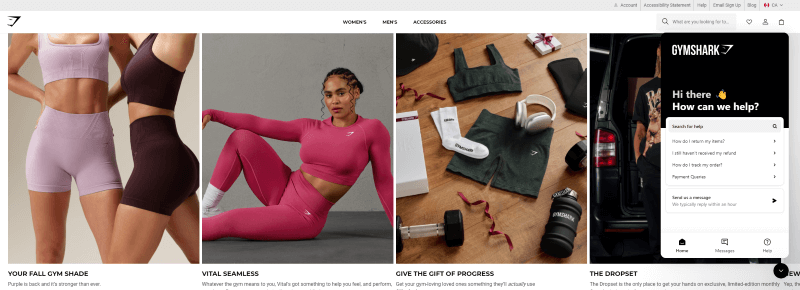
Successful brands are able to engage customers with personalized, targeted messaging throughout their lifecycle with your brand. This includes attracting them to your brand, establishing your brand as the best option, incentivizing a conversion, and engaging them post-purchase. But it’s increasingly challenging to provide personalized, on-demand support for customers at every stage of their journey, especially at scale.
Modern brands are turning to AI-powered chatbots that can actively engage customers based on where they are in their customer journey, what actions they’ve taken, and their past behavior. These chatbots then facilitate communication with the customer, supporting them along their customer journey. They also automatically optimize over time based on results and customer feedback, providing future customers with an even better experience.
Ecommerce chatbots give customers a direct line of communication to quickly and conveniently resolve common issues, without needing to get through to a call center (or wait on hold listening to elevator music!). Leading ecommerce marketers don’t just provide customers with a basic FAQ that funnels customers in an endless loop. Instead, they provide chatbots that automate customer communication throughout the entire customer journey, intuitively personalizing messaging based on what the customer needs at the time.
8. Speeding the buying journey with text-to-buy
Modern consumers want fast, frictionless experiences that conveniently, effortlessly, and seamlessly connect them with the products they want. But customers are constantly demanding that these processes be faster and more efficient, with less friction.
Text-to-buy is the latest and greatest for consumers looking for speed and convenience, allowing customers to easily buy with fewer steps in the shopping and checkout process. Text-to-buy shrinks the purchase path and confines it to a single channel — SMS messaging. Customers can go from receiving an SMS advertisement to ordering a product in a few simple clicks, all without ever leaving their messaging service. The result is a shorter shopping process that has fewer steps and provides customers a direct line of communication with your brand.
Walmart’s Text to Shop feature seamlessly integrates with its existing customers’ Walmart accounts. Customers are able to text WalMart an item they need, and it will automatically be added to a virtual shopping cart linked to their account. When ready, they can schedule a pickup or deliver — again with just a text. Customers also have the option to text and remove items they’ve added or review items they frequently order.
SImilarly, WineText offers one of the most simple, streamlined versions of the text-to-buy model. They send customers a daily WineText deal via SMS, and customers simply respond with a single number: the number of bottles they want to order. The wine is then delivered directly to their door.
Since SMS messages have comparably high open rates to email and even mobile push notifications, text-to-buy provides ecommerce marketers a way of drastically increasing their outreach and engagement rates. Successful ecommerce brands will make text-to-buy an integral part of their omnichannel marketing framework moving forward.
9. Facilitating ROPO and ROBO
In today’s ecommerce climate, very rarely is a customer’s first experience with a brand offline. Instead, customers who eventually buy in-store often find brands for the first time online, whether it’s through digital advertising, social media, or some other ecommerce marketing campaign. From there, customers then continue to research the brand — and compare it against competitors — online before ever visiting a store to make a purchase.
For these reasons, ROPO (Research Online, Purchase Offline), alternatively called ROBO (Research Online, Buy Offline), has been on the rise in recent years.
In the past, this was largely because most brands had an online presence that allowed customers to search their products but didn’t actually facilitate online ordering. Now that most brands do have online ordering capabilities, the popularity of ROPO is tied to products that customers prefer to view in person before making a final purchase decision.
For example, customers who use ROPO to order clothing are able to actually physically view the product when they buy it in-store, so they can verify their size and fit, feel the texture of the fabric, and even return the product then and there. Similarly, customers rarely buy a vehicle without being able to see and compare it in person, and frequently want to test drive a vehicle before buying. However, these customers often do extensive research online before ever visiting a dealership. Depending on your brand’s industry and niche, ROPO offers and processes will need to be drastically different to fit your customers’ needs.
Regardless of whether your product is suited to ROPO or not, it’s important that brands understand the relationship between online engagement and in-store conversions. Brands will need to understand what their customers prefer in terms of ROPO offerings to increase engagement and conversion rates.
10. Gamifying customer experiences
Games are fun, exciting, and interactive. They get players engaged and focus them on achieving a particular goal.
In recent years, retail brands have found new and innovative ways of leveraging gamification as an engagement and retention strategy. Brands can not only integrate games like scratch-and-win or spin-the-wheel into their marketing campaigns, but they also tie these games to rewards.
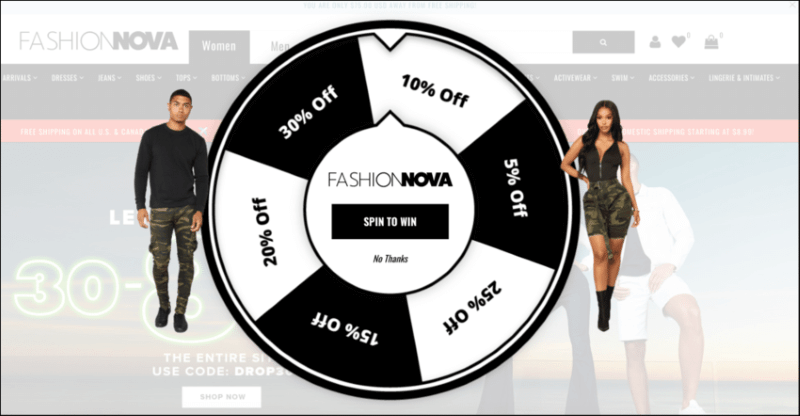
Customers can earn rewards points, special prizes, freebies, and more, encouraging consistent participation. Over time, these efforts foster regular engagement and help build brand loyalty.
McDonald’s Monopoly is a classic, popular version of retail gamification, with a strategy that directly ties purchases to exclusive rewards. Modern clothing brands like FashionNova also use gamified elements like spin-the-wheel to make their offers more fun and exciting, while also encouraging customers to return regularly to take advantage of potential discounts.
11. Using subscription models to guarantee reconversions
Of course, subscription models aren’t exclusive to ecommerce brands. However, since pioneers like Amazon have adopted this model, it’s seen more use in the ecommerce space. In 2023, the subscription ecommerce market grew to $193.6 billion, and it’s anticipated to reach $5,014.4 billion by 2032.
A major contributing factor is the increased adoption of video streaming services like Netflix, Amazon Prime, Disney+, and Crave, all of which use a subscription model to gate access to their digital content.
But subscription models are being increasingly used in the ecommerce industry as a way of increasing consistent engagement and fostering deep brand loyalty that lasts. Many clothing, fashion, beauty, and wellness brands use subscription models where customers receive a unique product each month, delivered directly to their door.
ButcherBox provides customers curated boxes of high-quality meats each month. Allure Beauty Box lets customers choose between annual, quarterly, and monthly plans, sending members boxes of curated beauty products. Subscription members also get exclusive discounts when buying luxury beauty products.
With this model, brands are no longer left waiting for customers to place orders; instead, they’re repeat business is automated. For this reason, many ecommerce brands are adopting subscription models that encourage customers to repeatedly engage and buy with your brand.
12. Generating content and images using Generative AI
Generative AI chatbots like ChatGPT are all the rage, and every single business is finding ways of leveraging these tools to streamline operations and improve efficiency.
Ecommerce marketers are leveraging ChatGPT to generate engaging marketing material for their campaigns, saving them considerable time having to build them from scratch. Instead, marketers can provide ChatGPT prompts to curate content and images that reflect their brand’s voice and tone, for various use cases and channels.
How to Capitalize on Ecommerce Trends Using MoEngage
The retail landscape is extremely competitive, making it difficult for ecommerce marketers to make sure their brands stand out. Generic, static messaging is also no longer enough; customers expect experiences that speak directly to them and their personal preferences and needs.
Hence, brands will need to focus on delivering personalized experiences across the entire customer journey. They will need to find creative, innovative ways of integrating new technologies into their retail marketing strategy, including augmented reality (AR), voice and image searches, and livestream shopping. They will also have to find ways of leveraging AI to automate and improve processes so they can not only increase engagement, but also improve operational efficiency.
MoEngage’s cross-channel marketing platform empowers brands to convert first time visitors into long-term, loyal shoppers that make repeat purchases and advocate for your brand. We help ecommerce marketers develop innovative campaigns that grasp customer attention and build seamless customer journeys that funnel customers through to purchase.
Schedule a demo with our sales team to learn how we can help you deliver best-in-class customer experiences that help you stay on top of the most important ecommerce trends.













